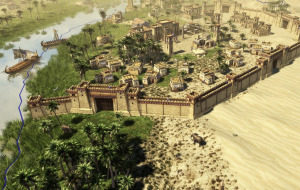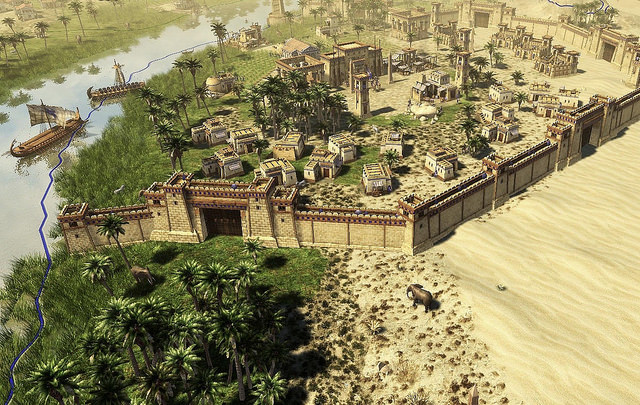
YALE UNIVERSITY—A new study linking paleoclimatology—the reconstruction of past global climates—with historical analysis by researchers at Yale and other institutions shows a link between environmental stress and its impact on the economy, political stability, and war-fighting capacity of ancient Egypt.
The team of researchers examined the hydroclimatic and societal impacts in Egypt of a sequence of tropical and high-latitude volcanic eruptions spanning the past 2,500 years, as known from modern ice-core records. The team focused on the Ptolemaic dynasty of ancient Egypt (305-30 B.C.E.)—a state formed in the aftermath of the campaigns of Alexander the Great, and famed for rulers such as Cleopatra—as well as material and cultural achievements including the great Library and Lighthouse of Alexandria.
Using an interdisciplinary approach that combined evidence from climate modelling of large 20th-century eruptions, annual measurements of Nile summer flood heights from the Islamic Nilometer—the longest-known human record of environmental variability—between 622 and 1902, as well as descriptions of Nile flood quality in ancient papyri and inscriptions from the Ptolemaic era, the authors show how large volcanic eruptions impacted on Nile river flow, reducing the height of the agriculturally-critical summer flood.
The findings, published in the journal Nature Communications, show that integrating evidence from historical writings with paleoclimate data can advance both our understanding of how the climate system functions, and how climatic changes impacted past human societies.
“Ancient Egyptians depended almost exclusively on Nile summer flooding brought by the summer monsoon in east Africa to grow their crops. In years influenced by volcanic eruptions, Nile flooding was generally diminished, leading to social stress that could trigger unrest and have other political and economic consequences,” says Joseph Manning, lead author on the paper and the William K. & Marilyn Milton Simpson Professor of History and Classics at Yale.
The reason for reduced flooding of the Nile is because volcanic eruptions can disrupt the climate by injecting sulfurous gases into the stratosphere, says Francis Ludlow, the study’s corresponding author. Ludlow is a climate historian who began collaborating with Manning as a postdoctoral fellow at Yale, and is now based in history in Trinity College, Dublin. These gases react to form aerosols that remain in the atmosphere in decreasing concentrations for one or two years, reflecting incoming solar radiation back to space. These volcanic aerosols can influence global hydroclimate. The reduction in surface temperatures can lead to reduced evaporation over waterbodies, and hence lessen rainfall. If the aerosols are dispersed primarily in the Northern Hemisphere, the greater cooling in this hemisphere can also diminish the summertime heating that drives the northward migration of monsoon winds over Africa up to the Ethiopian highlands where the Blue Nile is supplied with its summer floodwaters.
Because the Ptolemaic era is one of ancient Egypt’s most well-documented periods, the dates of major political events are known with some confidence, note the researchers, adding that what is often less clear from the ancient writings is what specific factors triggered events like revolts. The researchers were able to show a recurring close timing between such events and the dates of major volcanic eruptions. Knowledge of the historical context is essential to fully understanding how shocks from diminished Nile flooding acted to trigger revolts and constrain Ptolemaic war making, say the researchers, explaining that the shocks from poor Nile flooding would have occurred against a background of multiple socioeconomic and political difficulties that would have compounded the impacts of Nile variability.
“Egypt and the Nile are very sensitive instruments for climate change, and Egypt provides a unique historical laboratory in which to study social vulnerability and response to abrupt volcanic shocks,” says Manning. “Nile flood suppression from historical eruptions has been little studied, despite well documented Nile failures with severe social impacts coinciding with eruptions in 939, in 1783-1784 in Iceland, and 1912 in Alaska,” he adds.
“With volcanic eruption dates fixed precisely in time, we can see society in motion around them. This is the first time for ancient history that we can begin to talk about a dynamic understanding of society,” says Manning.
According to Manning, this research not only alters the perception of climatic changes on various scales, from short-term shocks to slower-moving, long-term changes, but it is also revolutionizing the understanding of human societies and how the forces of nature shaped them in the past. “The study is of particular importance for the current debate about climate change,” says Manning.
“It is very rare in science and history to have such strong and detailed evidence documenting how societies responded to climatic shocks in the past,” says Jennifer Marlon, research scientist in the Yale School of Forestry & Environmental Studies, and a co-author on the study.
The study reflects a significant advance in the integration of research among scientists and historians, and points to the need for more interdisciplinary scholarship to better document and analyze how humans have related and responded to past environmental changes, says Marlon.
The researchers note that the study provides historical context for what is happening today and what may happen in the future and demonstrates that there is need for further investigation into the effects of climate change on modern societies worldwide.
“There hasn’t been a large eruption affecting the global climate system since Mount Pinatubo in the Philippines in 1991,” says Manning. “We are living in a period where we are fairly quiescent in terms of large volcanic eruptions that are affecting climate. A lot of volcanoes erupt each year but they are not affecting the climate system on the scale of some past eruptions. Sooner or later we will experience a large volcanic eruption, and perhaps a cluster of them, that will act to exacerbate drought in sensitive parts of the world.”
___________________________________
A fortified Ptolemaic Egyptian town next to the Nile River. Wildfire Games, Wikimedia Commons
_______________________________________________
Article Source: Yale University news release
_______________________________________________
Other authors on the study are Alexander R. Stine, San Francisco State University; William R. Boos, University of California-Berkeley; and Michael Sigl, Paul Sherrer Institute.
_______________________________________________
Receive 30 days free access to the popular new CuriosityStream lineup of documentaries on science, history, nature, and technology as a new Popular Archaeology premium subscriber.
___________________________________________
Travel and learn with Far Horizons.
____________________________________________







